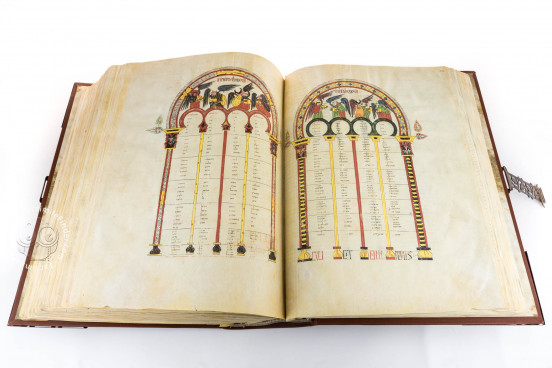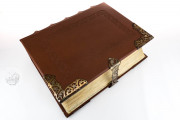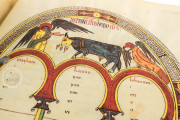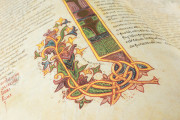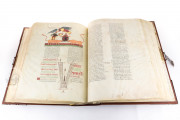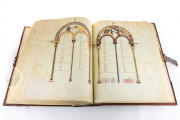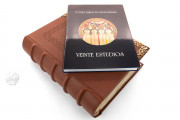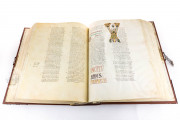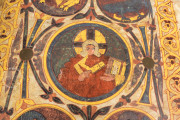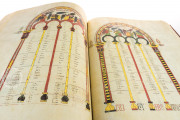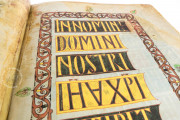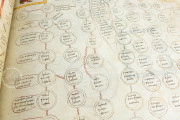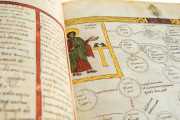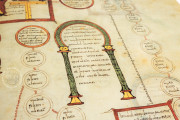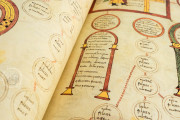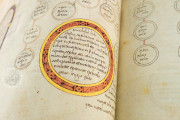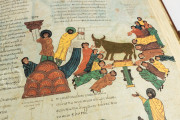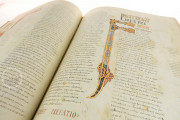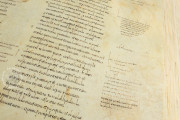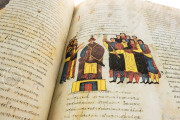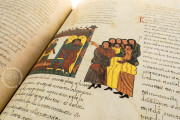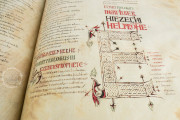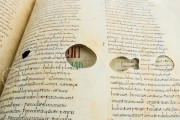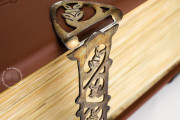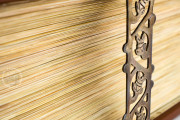The most densely illuminated Bible of the first millennium, the Visigothic-Mozarabic Bible of San Isidoro, also known as the Bible of León and the Biblia Primera, is a priceless source of information about the transmission of text and image in early medieval Europe. Created at the Monastery of Saints Peter and Paul at Valeránica near Tordómar in northern Spain, it was completed on 19 June 960 by the scribe Sanctius. It contains the complete text of the Latin Bible.
The large tome opens with a full-page image of Christ in Majesty surrounded by the symbols of the four evangelists (fol. 2r), which is shortly followed by an illustrated genealogy of Christ extending over ten pages (fols. 5v-10r). The Bible closes with a full-page treatment of the omega (fol. 514r), the final letter of the Greek alphabet. It is justly famous for its Old Testament narrative scenes illustrating episodes from the lives of the patriarchs, the kings, and the prophets.
A Link to Early Christianity
More than ninety Old Testament illustrations are dispersed through the text, each scene following its description in the biblical text. This arrangement reflects the appearance of images in early Christian rolls and biblical codices and suggests that the models for some of the manuscript's illustrations may reach back into late antiquity.
Styles from Many Cultures
The painted embellishment of the Bible reflects a variety of influences. Initials and framing elements incorporate interlace motifs reminiscent of early Insular art, and the opening miniature of Christ in Majesty and the canon tables occupied by the evangelist symbols betray the creators' awareness of eighth- and ninth-century manuscript art of the European mainland north of the Pyrenees.
Characteristic Example of Tenth-Century Iberian Art
The illumination of the Bible of San Isidoro, while receptive to influences from northern Europe, is characteristic of the quintessential directness of tenth-century Spanish illumination. The colors are bold and used to decorative effect. Human and animal figures are shown either frontally or in strict profile with no sense of movement or volume. In groups of figures, depth is suggested only by the heads of those behind being depicted above those of the figures in front. Also characteristically Iberian is the use of horseshoe arches in the canon tables (fols. 396v-404v).
Superb Example of Visigothic Script
The Bible of San Isidoro is "Mozarabic" by virtue of its origin in a Christian milieu in Spain when Muslim culture dominated the Iberian Peninsula. It is "Visigothic" because it is written in the regional script developed in Spain in the early eighth century, Visigothic Minuscule. The writing in the Bible displays the script's characteristic spikiness, made all the more prominent by the two-column format of the text, which is a mixture of the Vulgate and the Old Latin versions of the Bible.
Sanctius, Pupil of the Illustrious Florentius
The scribe responsible for writing the Bible of San Isidoro, Sanctius, is named three times in the manuscript, in one instance (fol. 513v) in conjunction with an indication of its date of completion. Sanctius is also pictured—joined by his teacher, Florentius, in raising a glass at the manuscript's completion—on the Omega page. Florentius, famous in his own day and known to have been active as a scribe at Valeránica for decades, may have played a role in the creation of the Bible, but the accompanying text does not make such a claim.
Valeránica's Decline and San Isidoro's Gain
The monastery at Valeránica seems to have fallen into decline as early as the twelfth century and its manuscripts dispersed. The Bible was at San Isidoro in León by 1163, when it served as a model for an illuminated Bible copied there (León, Archivo Capitular de la Real Colegiata de San Isidoro, MS 3). It is thanks to this twelfth-century manuscript (the Biblia Secunda, or second Bible) that the Visigothic-Mozarabic Bible of San Isidoro earned the nickname of Biblia Primera (first Bible).
We have 1 facsimile edition of the manuscript "Visigothic-Mozarabic Bible of San Isidoro": Biblia Visigótica Mozárabe de San Isidoro facsimile edition, published by Fundación Hullera Vasco-Leonesa, 1997
Request Info / Price

